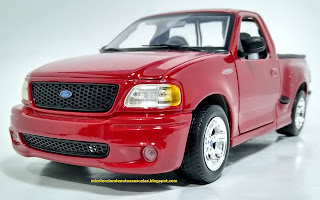Este es un blog de fotografías para la colección personal de autos de diferentes escalas.
Thursday, May 28, 2015
1981 Firebird Trans-Am Coors Bandit Choppers
The effect of Smokey and the Bandit on the pop culture landscape went far beyond what could have been imagined back in 1977. After 30 years, multiple sequels, a made-for-TV spinoff, and the retirement of Pontiac, even non-movie car fans still associate the character "Bandit" with black & gold second generation Firebirds. In 2005, customizer Jesse James had achieved fame on the Discovery Channel's Monster Garage and was asked by the Coors brewing company (makers of the contraband featured in the first film) to build a special tribute car as the grand prize in a contest they were running. The result was the "Coors Bandit," a 1980 Firebird featuring combination scissor doors, a racing interior, West Coast Chopper 3-piece wheels, and a 700 horsepower engine with ProCharger induction. The contest was promoted through a series of limited edition 6-packs and a 1/24 scale replica of the car sold exclusively at Wal*Mart.
Thursday, May 21, 2015
2006 Dodge Stratus Von Dutch NHRA Frank Pedregon Funny Car
Thursday, May 14, 2015
F1 Lubrax Petrobras #5 Fórmula 1
Thursday, May 7, 2015
2006 Mercedes Benz SLK55 AMG
Tuesday, April 28, 2015
2002 Ford F-150 SVT Lightning Maisto Escala 1:21

The Ford SVT Lightning is a sports/performance version of the F-150, developed by the SVT (Special Vehicle Team) division of Ford. For 1999, the second generation of the Lightning was released using the PN96 platform, after a three-year hiatus of the model line. As with its 1993-1995 predecessor, the Lightning was based on the F-150; all versions were produced with a regular cab, rear-wheel drive, and a 6½-foot bed length. In sharp contrast to its predecessor, the 1999-2002 Lightning was given a payload of 800 pounds (half the payload of a Ranger); for 2003, the figure was raised to 1,350 pounds.
While the first-generation Lightning chassis was a hybrid of the F-150 and F-250, to save weight and lower its cost, the second-generation adopted the stock F-150 frame. To improve handling, while the stock short/long arm front suspension configuration was used, the Lightning was lowered one inch with a 31mm stabilizer bar; the rear solid axle with leaf springs was lowered two inches, using a 23mm stabilizer bar. Monroe shocks were used from 1999 to 2001; Bilstein shocks were used from 2002 to 2004. In place of the 17-inch wheels of its predecessor, the second-generation Lightning was given 18-inch wheels with Goodyear Eagle F1 directional tires developed for the truck.
The second-generation Lightning was powered by a 5.4 L Triton SOHC V8 equipped with an Eaton M112 supercharger. At its launch, the Lightning produced 360 hp (268 kW; 365 PS) and 440 ft⋅lbf (597 N⋅m) of torque, increased to 380 hp (283 kW) and 450 ft⋅lbf (610 N⋅m) of torque in 2001. The supercharged V8 was paired with a 4-speed Ford 4R100 overdrive automatic transmission (shared with the 5.4L V8, 6.8L V10, and 7.3L diesel). From 1999 to 2000, the rear axle ratio was 3.55:1, shortened to 3.75:1 in 2001. The same year, a 4.5-inch aluminum driveshaft replaced a 3.5-inch steel unit.
Following the 2001 drivetrain revisions, Car and Driver magazine tested a Lightning, accelerating from 0-60 mph (97 km/h) in 5.2 seconds.
During its production, the 1999-2004 was offered in a limited variety of colors. Initially produced in Bright Red, Black, and White, for 2000, Silver was introduced. For 2002, True Blue (a very dark blue) was introduced, but was replaced by a lighter Sonic Blue for 2003, along with Dark Shadow Gray.
























































